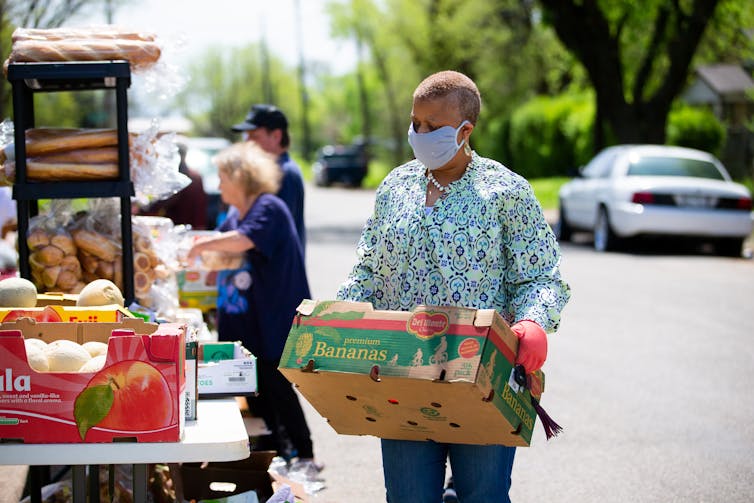
Kevin Gosine, Brock University; Darlene Ciuffetelli Parker, Brock University, and Tiffany L. Gallagher, Brock University
You’ve likely walked past that non-profit youth centre or literacy program in your neighborhood countless times. You’ve probably never needed to make use of it and never given it a second thought.
But on your next stroll, take a moment to consider the work that organization does, the challenges it faces and the vast benefits it brings to your community.
In an age of proliferating social troubles and government retreat, Canadians must be aware of the critical role played by the non-profit sector.
Recent decades have seen the welfare state withdraw in favour of free-market principles. In a neoliberal era, where profitability is prioritized over social duty, all orders of government in Canada have shirked much of the responsibility for providing social services onto non-profits.
Importance of social connections
As non-profits have become saddled with more obligations, they are handcuffed by limited funding. Long-term funding arrangements between governments and non-profits have been replaced by provisional and competitive funding. While non-profits are expected to do significantly more, they are relegated to coping with far fewer resources.
This has serious implications for the long-term well-being of communities, especially those already marginalized and under-served.
Not only are non-profits now providing critical services and social supports for which the state previously took responsibility, they are also settings where vital forms of social capital are produced.
Social capital refers to networks of trust, belonging and support developed among people within a given community (bonding social capital), and between people who identify with different communities or social groups (bridging social capital). Social capital enables people to work together toward mutual well-being and goal attainment.

Social capital doesn’t just happen
Communities must find ways to create worthwhile forms of social capital. And that’s where non-profit organizations can fill a gap. However, constantly scrambling for money leaves these organizations little time, resources and capacity to provide programming that fosters social capital.
Our research on community literacy organizations illuminated the role of non-profit organizations in helping people cultivate social capital. We conducted interviews and focus groups with program leads, staff and service users at eight non-profit organizations in southern Ontario to learn how they support literacy in their communities.
We found that producing social capital enabled them to serve communities in ways that transcended their primary mandates.
It is unrealistic to expect people to build social capital on their own, devoid of enabling social infrastructure. The challenge of creating meaningful social connections is daunting. Especially as society becomes increasingly individualistic. Religion — once a stalwart source of community — continues to decline and technology is rapidly displacing face-to-face human interaction. Urban planners and community stakeholders need to provide the settings and opportunities for people to come together, connect and collaborate.
We found that non-profit community programs serve as settings where people from marginalized backgrounds can build beneficial forms of social capital. Such local initiatives provided individuals with recurrent and predictable channels to interact, share lived experiences and work together.
For example, mothers of children with disabilities participated in self-help groups where they shared their experiences, exchanged information and generally supported one another. Civic projects, such as a community garden started at one organization, brought together residents, young and old.
Non-profit programs provide people with opportunities to interact with different community members and forge meaningful interactions with people outside their social group that mitigate prejudice and foster trust and understanding.

Over the course of our research, we saw what started as bridging social capital strengthen into bonding ties between program participants, and in many cases between program users, staff and volunteers. The significance of these bonds was powerfully conveyed by one participant who took part in our study:
… what I take away from this group [is] that there are good people still left in a world that’s so scary, and people that are there to support. And whether I’m here or not, they’re always willing to help somebody else that’s in need. And… knowing that the option of … being there and the people that come together for this group–it’s really incredible to know that you have somebody.
The programs we studied connected individuals to new people, organizations, supports and resources and provided ongoing opportunities to build bridging social capital.
While the primary purpose of the non-profit organizations was to improve literacy, these programs accomplished much more. By providing a judgement-free safe space where participants had opportunities to share and collaborate, these organizations fostered social capital within communities.
The community organizations we studied had recently lost their primary funding provided by a regional anti-poverty program. Program leads and staff remained committed to supporting service users but struggled to do so given the need to devote more time and resources to addressing funding insecurities.
Benefits of social capital
When social capital is actively fostered, social trust is elevated. Research has demonstrated that the more non-profit organizations there are in a community, the lower the crime rate. Non-profit organizations help to lessen crime by enhancing levels of social capital and trust and expanding opportunities and hope.
Strengthening people’s social and organizational ties broadens their horizons and improves their well-being. Non-profits play a crucial role in fostering and sustaining such social capital.
If governments expect communities to be viable and fend for themselves amid diminishing public support, local non-profits cannot be relegated to financial precarity. By starving the non-profit sector, governments are ironically undermining the capacity of communities to live up to the neoliberal ideals of self-reliance and local resourcefulness.![]()
Kevin Gosine, Associate Professor, Department of Sociology, Brock University; Darlene Ciuffetelli Parker, Professor, Department of Educational Studies; Director, Teacher Education, Brock University, and Tiffany L. Gallagher, Professor, Department of Educational Studies and Director, Brock Learning Lab, Brock University
This article is republished from The Conversation under a Creative Commons license. Read the original article.


